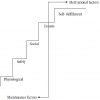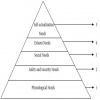Home | ARTS | Management Concepts & Organisational Behaviour
|
Alderfer’s Existence-Relatedness – Growth (Erg) Model - Motivation
Management Concepts & Organisational Behaviour - Motivation
Alderfer’s Existence-Relatedness – Growth (Erg) Model - Motivation
Posted On :
Serious doubts have been expressed about the existence of the five distinct need categories which Maslow hypothesized.
Alderfer’s
Existence-Relatedness – Growth (Erg) Model
Serious doubts have been expressed about the existence of the five distinct need categories which Maslow hypothesized. There seems to be some over-lapping between the security, social and physiological need. Also, the lines between esteem, social and self-actualization needs are not entirely clear. With these points in mind, Clayton Alderfer condensed Maslow’s need categories into three sets:
-- Existence needs. These include all forms of materials and Physiological and safety needs, i.e., Maslow’s first two levels of needs.
-- Relatedness needs. These include all needs that involve relationships with other people we care about. The examples include anger and hostility as well as friendship. Thus, the opposite of satisfaction of relatedness needs is emotional distance rather than hatred. Relatedness needs cover Maslow’s social needs and that of esteem needs which are derived from other people. – Growth needs – These needs involve persons making creative efforts to achieve full potential in the existing environment. It is like Maslow’s highest level need of self-actualization.
Alderfer also revised Maslow’s theory in three other ways:
1. He argued that the three need categories form a hierarchy only in the sense of decreasing concretions. That is, as we move from a focus on the existence to relatedness to growth needs, the ways can satisfy those needs become increasingly abstract.
2. He recognized that rise in the
level of satisfaction of our existence and relatedness needs may result in
decrease in their importance to us. Growth needs become more important as we
successfully satisfy them. That is, as we are able to be productive and
creative, we look to higher goals and, in so doing, are again dissatisfied.
3. He reasoned that we are likely to
try to first satisfy the most concrete needs and then to move on to more
abstract needs. In this sense, Alderfer sounds somewhat like Maslow, suggesting
a pattern of satisfaction progression- that is, as one need is satisfied, we
progress to next higher need.
Alderfer conceived ERG needs along a continuum which avoids the implication that the higher up an individual is in the hierarchy the better it is. Different types of needs can operate simultaneously. If a particular path towards the satisfaction is blocked, the individual will both persist along that path and at the same time regress towards more easily satisfied needs. In this way, Alderfer distinguishes between chronic needs which persist over a period of time and the episode needs which are situational and can change according to the environment.
Serious doubts have been expressed about the existence of the five distinct need categories which Maslow hypothesized. There seems to be some over-lapping between the security, social and physiological need. Also, the lines between esteem, social and self-actualization needs are not entirely clear. With these points in mind, Clayton Alderfer condensed Maslow’s need categories into three sets:
-- Existence needs. These include all forms of materials and Physiological and safety needs, i.e., Maslow’s first two levels of needs.
-- Relatedness needs. These include all needs that involve relationships with other people we care about. The examples include anger and hostility as well as friendship. Thus, the opposite of satisfaction of relatedness needs is emotional distance rather than hatred. Relatedness needs cover Maslow’s social needs and that of esteem needs which are derived from other people. – Growth needs – These needs involve persons making creative efforts to achieve full potential in the existing environment. It is like Maslow’s highest level need of self-actualization.
Alderfer also revised Maslow’s theory in three other ways:
1. He argued that the three need categories form a hierarchy only in the sense of decreasing concretions. That is, as we move from a focus on the existence to relatedness to growth needs, the ways can satisfy those needs become increasingly abstract.
Alderfer conceived ERG needs along a continuum which avoids the implication that the higher up an individual is in the hierarchy the better it is. Different types of needs can operate simultaneously. If a particular path towards the satisfaction is blocked, the individual will both persist along that path and at the same time regress towards more easily satisfied needs. In this way, Alderfer distinguishes between chronic needs which persist over a period of time and the episode needs which are situational and can change according to the environment.
Tags : Management Concepts & Organisational Behaviour - Motivation
Last 30 days 372 views














